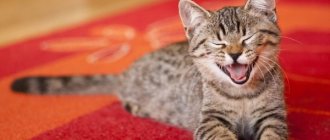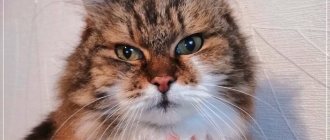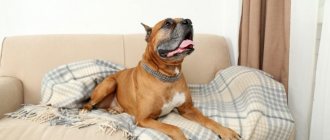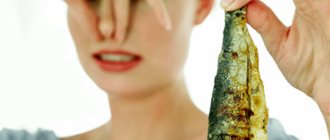Wool on furniture and carpets, unscented marks in unexpected places, and a specific smell in rooms are serious problems that need to be dealt with immediately.
Otherwise, soon friends and acquaintances will stop coming into the apartment, and people on the street will avoid the owners.
How to remove dog smell in an apartment or house? Modern household chemicals, homemade solutions and professional advice will help you combat the problem.
We identify the cause of the dog smell in the apartment - why does it smell like a dog?
First of all, you should find out where the smell actually comes from?
The smell can appear both from the pet itself and from its bed . And also from furniture, carpets and other corners where you can sleep, bury a chicken leg or lift your paw. The same applies to cat smells in the apartment.
Well, of course, it is equally important to find the cause of this smell.
You will be surprised, but the most common reason is the laziness of the owners.
How to find the source
To eliminate an unpleasant odor, you must first find its source. This is easy to do if the mouse corpse lies on the floor and is visible to the naked eye. But very often rodents die in hard-to-reach places. How to find the source of the smell in this case?
In old furniture
Rodents can make a nest or simply hide in old furniture. If the smell comes from the sofa, you need to unfold it and carefully inspect it. A dead mouse may end up under removable parts of the body or under the upholstery; to find the corpse, the boards must be unscrewed and the upholstery removed or torn off.
Under the baseboard
Mice that run into an apartment can climb into the gap between the wall and the baseboard and die there. In order to find the corpse of a rodent in such a shelter, you need to dismantle the baseboards.
In the ventilation
A favorite place for mice to hide is ventilation. If the rodent died there, the smell will spread throughout the room.
In a bag of cereals or flour
Animals are attracted to food storage areas. If cereals or flour are not stored in sealed containers, but in bags or bags, mice gnaw through the fabric and get inside.
So, the reasons for the “dog” smell in your home...
- "The odor of the rock." Yes, that happens. Not all dogs, alas, smell of flowers and vanilla shampoos. Actually, such dogs simply do not exist. If only immediately after a shower and only for a few hours. In general, dogs can be highly odorous and practically odorless. For example, spaniels and shepherd dogs are the most “smelly” of all breeds, but in Chinese crested dogs the smell appears only if the dog has not been washed for 1-2 months.
- Hygiene reasons. You will be surprised again, but the dog should be washed. Optimally - once a month, if your affectionate and gentle animal is indoor. Less often if the animal lives on the street. Natural fats accumulated in wool over time emit a very unpleasant odor. And yeast fungi living on the skin and multiplying aggravate this problem. Train your pet to bathe from infancy, and the odor problem will be solved by 50%.
- Incorrectly chosen bathing products. Not everyone knows, so owners should take note: human shampoos are not suitable for pets! The acidity of these products is not for the fur and skin of four-legged animals. Choose a shampoo specifically for your pet. Don't skimp on shampoo! Cheap products do not remove odor well, dry out the skin too much and damage the coat. In addition to the shampoo, buy a special product that will restore the structure of your friend’s coat and eliminate the unpleasant odor. The choice of such funds today is quite wide. Remember that a powerful alkaline bathing product (and even without balm) disrupts the production of sebum and, as a result, a strong odor.
- Blockage of the anal glands. If you notice that your pet is intensively licking the area around the anus, rolling on its butt, trying to bite itself on it, or itching for no reason, it’s time to clean the glands. Otherwise, inflammation may begin. The smell always appears with this phenomenon, and, of course, not the most pleasant one.
- Excessive wax in the ears or otitis media. If your dog is not accustomed to cleaning its ears, the smell from them will haunt you constantly. But it’s even worse if otitis media begins - this smell is very specific, it is difficult to confuse it with the usual “sulfur”. If you have any doubts, it is better to consult a veterinarian.
- Smell from the mouth. Again, the dog should be trained to brush its teeth. In addition, special toys, food and treats can be used to remove plaque. But only a specialist can remove tartar.
- Seborrhea. It is characteristic of specific breeds and produces a rather intense odor at the end. Seborrhea is observed, as a rule, in all hunting breeds. The reason is simple - intensive work of the sweat and sebaceous glands, as well as increased production of sebum (approx. - 30% stronger than in other breeds), as protection from getting wet.
- Improper digestion. Feed your dog correctly! Allergies and disturbances in the gastrointestinal tract begin from disorderly and illiterate feeding, unsuitable feed, human products and “biting”. And, accordingly, skin problems. Everything here is like with people: if you eat all sorts of “nonsense”, then pimples on your face, excess weight and severe sweating will haunt you endlessly. Odor often appears from dogs that are fed fish or “fish” food.
- Seasonal reasons. The dog smell always gets stronger in the summer. Firstly, the pet is hot. You can wear shorts and a T-shirt, but the dog has nowhere to undress. In addition, in the summer, dogs often plunge into all the rivers, small ponds and even puddles located near the house to cool off. And wool always smells sharply sour when wet. And various microorganisms multiply more actively in wet wool, which also does not add aroma.
- Physiological reasons. For example, hormonal surge, obesity, metabolic disorders and other human “sores”. However, it is worth noting that males are initially more odorous than females. The exception is the period of estrus. Therefore, if a bitch’s odor appears outside of her period of heat, consult a doctor (this is a symptom of serious problems in the “female line”).
- Diseases. If you bathe your pet regularly with medicated shampoo, dry it properly, feed it, walk it, and it still smells, consult a doctor. A strong unpleasant odor can be a symptom of infection, liver or gastrointestinal diseases, ears, allergies, abscesses and even oncology. Remember that a sweet or “antifreeze” smell from your pet’s mouth is a reason to urgently go to the veterinarian.
Functions of the glands
In the animal kingdom, smells are a tool for protection and communication. Any animal has a unique scent, thanks to which another predator can identify it. Domestication of canines did not contribute to the disappearance of this marker.
Often, owners of four-legged animals are faced with an unpleasant odor emanating from their pets. Studying the mechanism of its formation will help solve the problem. The theory of excessive sweating does not work in the case of dogs because they do not sweat much. The only exception is the area of the paw pads. In most cases, the repulsive aroma is formed in the glands located in the epidermis.
The characteristic odor of wool is not associated with excessive sweating
Any animal has aromatic glands that produce certain substances. Depending on the state of the body, the degree of their intensity changes.
Table 1. Types of glands
| Type of gland | Characteristic |
| Skin | Produces lubricant for hair. The total number and sensitivity determine the level of “odor” of the pet. Pets living in extreme natural conditions have a larger number of fatty glands. The skin of short-haired pets also has a dense layer of fat. Dogs without undercoat produce a large amount of lubricant, which makes the smell of wet fur more intense. |
| Sweat | Located between the paw pads. Many owners note a specific aroma of the limbs, which intensifies in summer and winter. At best it resembles popcorn, at worst it resembles dirty socks. These sweat glands produce odorous substances that form the individual trace of the animal. |
Wool protects the body from external influences and enhances the heat-insulating qualities of the epidermis.
The skin of animals is lined with hairs that interact with hair follicles. Each root is connected to the sebaceous glands, with the help of which toxins are removed from the body. If the animal is sick or is taking medication, the smell intensifies. These glands also produce pheromones - external secretion products that attract the opposite sex.
Unpleasant Dog Odor – 14 Ways to Eliminate Dog Hair Odor
To make a dog’s fur smell—if not like flowers, then at least just clean—you need...
- Wash your dog with special “dog” products every 10-30 days, depending on the breed. Wash thoroughly with shampoo and be sure to use conditioner.
- Dry your dog after washing or swimming in water with a hairdryer or a special microfiber towel that absorbs water as much as possible.
- Clean your pet's ears and teeth regularly. Preferably using a special paste.
- Wipe the pet's fur with a solution of vinegar (approx. - 1 tbsp per 1 liter of water). The skin of hairless dogs can be wiped with chlorhexidine (at the same time, treat any inflammation on the skin).
- Brush your dog regularly , remove the undercoat, which accumulates moisture and spreads an unpleasant odor.
- After a walk, be sure to wash your paws, face, belly and area near the tail.
- Trim the area under the tail so that feces particles do not stick to the fur in this area. Don't forget that even the smartest pet doesn't know how to use toilet paper.
- Feed your dog correctly , taking into account the balance of all nutrients. Remember that not getting certain substances from food leads to metabolic disorders and, as a result, disruption of the sweat glands. Change your dog's diet completely - to a correct and balanced one, give up allergic foods, and perhaps this step alone will significantly reduce the size of the odor problem. Do not feed your pet raw meat/fish - cook without salt and steam it. This will protect your dog from helminths and subsequent problems with them, including odor.
- Have your dog examined by a veterinarian in a timely manner and get tested. Remember: a healthy dog smells, but does not stink. The unbearable smell of “dog” is the body’s signal of ill health.
- Be a caring owner. That is, treat the dog carefully, paying attention to its mood changes. The smell can also be a protective reaction to stress or fear, during which the sebaceous glands begin to actively produce an unpleasant “smell.” Eliminate the causes of stress and fear. Do not scold your pet, and especially do not use force.
- Use additional products when bathing your pet. For example, Doctor shampoo (by the way, it perfectly treats skin inflammation).
- You can also pay attention to dog “deodorants”: OdorGone, Smart spray, Faithful friend, “Essential 6 spot on dermoscent” drops.
- Wash clothes and pet mattress/bedding covers more often. At least once a week! And also wash his toys and put away his “stash” in the corners.
- Walk the dog more often and longer so that it relieves its natural needs not on the carpet in the apartment, but under a bush on the street.
Advice from professionals
To reduce the dog smell in your apartment to a minimum, you need to:
- Give your dog a permanent place and regularly care for the bed.
- Take care of her hygiene and brush her regularly.
- Do not mask the smell with aromatic sprays, especially those not intended for this purpose.
- Consider the characteristics of the breed when choosing a dog.
- Timely toilet training and keeping it clean.
- Provide your pet with proper nutrition.
- Visit the veterinarian regularly to prevent the occurrence of diseases.
Don't forget about the room, you need to:
- regularly carry out wet cleaning and disinfection;
- vacuum surfaces, paying attention to hard-to-reach places where hair accumulates;
- Clean carpets monthly.
By following some simple tips, you can avoid the appearance of unpleasant odors from your pet, interior items and your own clothes.
Shar Peis, Cocker Spaniels, Basset Hounds, and Beagles are the most “fragrant” breeds. Dog breeders often argue on this topic and argue that with proper care, the smell from the listed representatives is no greater than from all the others.
It is necessary to understand that only toy animals do not smell. It is impossible to completely rid your pet of its natural scent .
You will find a lot of useful and important information about removing various unpleasant odors from objects and surfaces in this section.
How to remove dog smell from carpet and furniture - 10 effective ways and means
It is worth noting that the smell appears on carpets and furniture in 2 cases:
- A dog lifts its paw more often in an apartment than outside.
- The dog is rarely washed, and the smell from it “eats” into the furniture and carpets.
Before removing odors from your apartment, follow the steps described above. Otherwise, any cleaning will be pointless.
- Remove puddles as soon as they appear. The smells of urine ingrained into the upholstery or carpet only become stronger over time. Do not smear the puddle - absorb it as much as possible with paper towels, and then treat it with special products and after half an hour, remove the remaining product with a vacuum cleaner.
- Sprinkle a thin layer of baking soda on the carpet (furniture area) and remove with a vacuum cleaner after 4-5 hours.
- For non-fabric surfaces, you can use a mixture of baking soda (2 tbsp), peroxide (20 ml) and regular dishwashing detergent (1 tbsp). This mixture should be applied to the “smelly” area, rubbed in and washed off after a couple of hours.
- Rinse the stain with a solution (approx. - weak and without grains!) of potassium permanganate. It helps neutralize ammonia.
- Use household products to remove odors. For example, whiteness, Domestos or Vanish, as well as Mr. Muscle and Mr. Proper. You can add a couple of drops of citrus essential oil to products containing chlorine.
- Dilute vinegar 1 to 1 , treat the desired area, and repeat after drying.
- Dilute 15 drops of iodine per 1 liter of water , treat the wooden surface, and wipe with a dry cloth.
- You can also use rubbing alcohol . We spray it from a spray bottle onto the desired area, rub it in, and absorb it with napkins until the alcohol is completely eliminated.
- For fabric surfaces, you can use household soap . We grate it, mix it with water until it becomes a paste, apply it to the odorous area and wash it off after 10 minutes.
- Lemon juice or fresh lemon peels. We simply wipe the furniture with juice or crust, and after 15 minutes with a regular damp cloth.
How to clean a carpet at home - recipes and tips for housewives
Dog breeds that don't smell
It is possible to state that there are dogs that have no smell and do not smell at all. Other factors that do not relate to the type of dog can also cause stench. But there are odorless breeds:
- Individuals with long hair without undercoat. It is more like human hair, and its property is also to absorb odors. This species produces very little sebum, which means there is practically no smell.
- Breeds with short and coarse hair without undercoat. With them, it gets wet very hard, therefore, little lubrication is produced. Therefore, such animals do not smell.
Dog breeds without foreign odor:
- Yorkshire Terrier. A decorative dog that will be an excellent pet for a city apartment. It was first used in England as a hunter of small rodents, and later as an ornamental pet. This breed is friendly, gets along well with children and other pets, and will never offend its owner.
- Brussels Griffon. Native of Belgium. The first time people heard about the dog was at the beginning of the 19th century. The breed was intended for catching mice and rats, and only then dogs began to be kept as pets. The animal is easy to train, is intellectually developed and becomes attached to its owner, and will become an excellent friend for adults and children.
- Dalmatian. This breed is popular for its unusual appearance and is in great demand among dog breeders. The dog is famous for its short and smooth coat, and has no undercoat, so at a young age it does not smell like a dog. However, as you age, the problem can arise.
- Shih Tzu. Country of origin: Tibet. Another name is Buddha's dog. It is believed that this breed brings happiness and prosperity to the owner’s home. The Shih Tzu has a majestic appearance and a friendly character; it will become a good friend for an elderly person and an ally in games for a child. The wool consists of flowing strands of decent length, which often become tangled. Therefore, such a dog must be properly cared for.
- Maltese. Homeland - Central Mediterranean. The dogs have long, silky hair. Previously, the Maltese dog could have different colors, today only white individuals are found. This breed is not predisposed to shedding. This dog is an unsurpassed companion and friend for the whole family.
- West Highland White Terrier. Country of origin: Scotland. Originally bred as a hunting burrowing dog, it is now bred as a decorative dog. The popularity of the breed is due to its snow-white coat without admixtures of other colors. Such dogs require training and education from a young age, as without them they remain stubborn and disobedient. Pets often need salon services. Personality: friendly and loyal.
- Bichon Frize. Homeland - France. The name, translated from French, means curly lapdog. The color is only white, small spots of peach color are acceptable only in puppies. The dogs have an unusual coat: curly, long and silky. Due to their characteristics, they require additional care. Bichon Frize are miniature animals that are suitable for living in an apartment.
- Scotch Terrier. Another name is Scottish Terrier. This hunting breed has a strong and muscular build. The dog has a pleasant appearance and a responsive character, is well trained, and knows how to stand up for itself and its owner. Care involves constant physical activity and long walks. Character is changeable; one minute an animal can be cheerful and playful, the next – irritated and unfriendly. You can eliminate mood swings with the help of training.
- Basenji. A large dog whose homeland is considered to be Central Africa. She has a sense of humor and gets along with adults, children and other pets. She has short, smooth fur that practically does not shed and does not have an unpleasant odor. Characteristic features that distinguish Besenji from other breeds are folds on the face, due to which the pet has a sad appearance, and a curled tail.
- Chinese Crested. A small and graceful dog that originated from the People's Republic of China. It comes in two types:
- hairless with hair on the head, tail and paws;
- completely covered with long hair without undercoat.
- Italian greyhound. The breed from Italy has an elegant and graceful body. She is a smaller copy of the Greyhound. The body is muscular and dry, the coat is very short and smooth. Dogs of this breed require training and constant physical activity. Their playfulness and intellectual development make them good companions. They quickly find a common language with young children, but do not get along well with larger relatives.
- Tibetan Terrier. A medium-sized dog with thick and shaggy hair. Even though it grows throughout its life, the Tibetan Terrier does not shed. Despite its toy appearance, the pet is muscular and hardy, suitable for both lovers of a quiet and active life. The main character quality is friendliness. Such a dog quickly becomes attached to its owner and is jealous of him.
Large breeds
Royal Poodle
The largest breeds that shed the least and smell the least are the Airedale Terrier and the Royal Poodle (see photo). When choosing one of these giants, you need to take into account that the dog may feel cramped in a small apartment. To know what each of these animals is, you need to study their characteristics, information about which is presented in the table:
Medium-sized pets
The list of non-shedding, medium-sized, odorless dog breeds includes many names. Some of the most popular are:
Fox terrier
- Basenji;
- fox terrier;
- Peruvian hairless dog;
- Xoloitzcuintle;
- American Hairless Terrier;
Irish Soft Coated Wheaten Terrier
- Irish Soft Coated Wheaten Terrier;
- Giant Schnauzer;
- miniature schnauzer;
- Scottish Terrier;
- Cairn Terrier;
- Staffordshire Bull Terrier.
Small dogs
Yorkshire Terrier
Small dogs such as the Chinese Crested, Maltese, Bichon Frize, Yorkshire Terrier, and West Highland White Terrier practically do not shed or emit an unpleasant odor. The first 3 breeds belong to the group of “decorative and companion dogs”. Each of the dogs listed is absolutely not slobbering. Studying their features will make choosing a pet much easier. General information about small dogs that do not have shedding hair and do not have an unpleasant odor is presented in the table:
You can also use the following tools:
- Apples. The recipe is simple: cut an apple in half and place it on the area where there is an unpleasant odor. The absorption of odors by fruit lasts up to 6 hours.
- Sprinkle cornstarch on the floor and vacuum after 3-4 hours. It absorbs odors as effectively as baking soda.
- Add 4-5 drops of essential oil to a spray bottle with warm water (aroma according to your “taste”), spray in the room - on curtains, carpets and floors. The advantages of the product are a pleasant aroma, as well as an antiseptic and antifungal effect.
- Use furniture covers. They are easier to wash than sofa upholstery.
- Use special products from veterinarians/pharmacies that remove organic odors. These products do not mask, but completely remove microorganisms that are sources of odors. For example, Vaportek and Le Artic, BIO-J and Zoosan, Bio-GM, UF2000, Ultrasan, Nature's Miracle Pet Stain & Odor Remover or ORANGE-OXY. These products are safe for both your pets and household members.
We will be very pleased if you share your experience or the results of recipes for removing dog odors in the apartment!
How to properly clean wood floors from dog urine
While the most unpleasant formations can be removed from the carpet quite quickly, the pungent dog “aroma” from a wooden floor is a dangerous problem. The appearance of dampness (if the dog peed in the same place several times) can lead to damage to the varnish and swelling of the laminate or parquet. Initially, dog urine is removed using a napkin or towel. You need to blot the puddle, wash the floor with clean water, and wipe dry. Next you can do the following:
- rub the laminate with lemon peel;
- make a paste of soda and water (change when dry);
- neutralize the stench by washing the flooring with a floor cleaner that smells of lavender and mint.
The use of ordinary bleach or powder is unacceptable: they will not help remove dog urine from the floor and will damage the coating (suitable only for light-colored linoleum). To prevent your dog from peeing on the floor again and the room smelling like urine, you can try a weaning spray. True, it rarely helps. If the dog begins to go to the toilet in the room due to old age, you will have to lay oilcloths or a medical diaper on the floor. Difficulties are also possible when an adult dog marks the territory due to the appearance of a cat.
Traditional methods
If it is not possible to purchase cleaning products at the pharmacy, then you can use traditional methods and sanitize with your own means.
Parsley removes heavy perfume very well.
- To do this, add chopped parsley to food, or give a whole sprig.
- Many dogs love to eat parsley, and the unpleasant odor disappears.
- You can make an infusion of parsley and give the dog a drink, but if he refuses such water, then you need to rinse your mouth with a syringe.
- Parsley is completely safe and can be used as much as you like.
Using coconut oil will also neutralize bad breath from the mouth.
- Adding it to ready-made food, while preparing porridge, or daily brushing of teeth will perfectly cope with the existing problem.
- Coconut oil is an excellent antibacterial, antiseptic, and antifungal agent.
- It will prevent the appearance of plaque, and with daily use you can notice a positive result.
An excellent remedy for combating foreign odors is yogurt, which is very useful not only for combating plaque, but also for preventing diseases of the gastrointestinal tract.
Tomato paste can be applied to gauze and wiped from the outside of the teeth every day, which will serve as an excellent preventive measure against the formation of tartar, and therefore against an unpleasant odor.
If the dog doesn’t mind gnawing on a carrot, then gnawing on it removes food debris from the teeth. Carrots can be a great substitute for bone.
You can make your own toothpaste:
- Bouillon cube;
- Soda;
- Salt;
- Parsley;
- Water.
Mix everything thoroughly and clean the animal’s mouth with a toothbrush.











